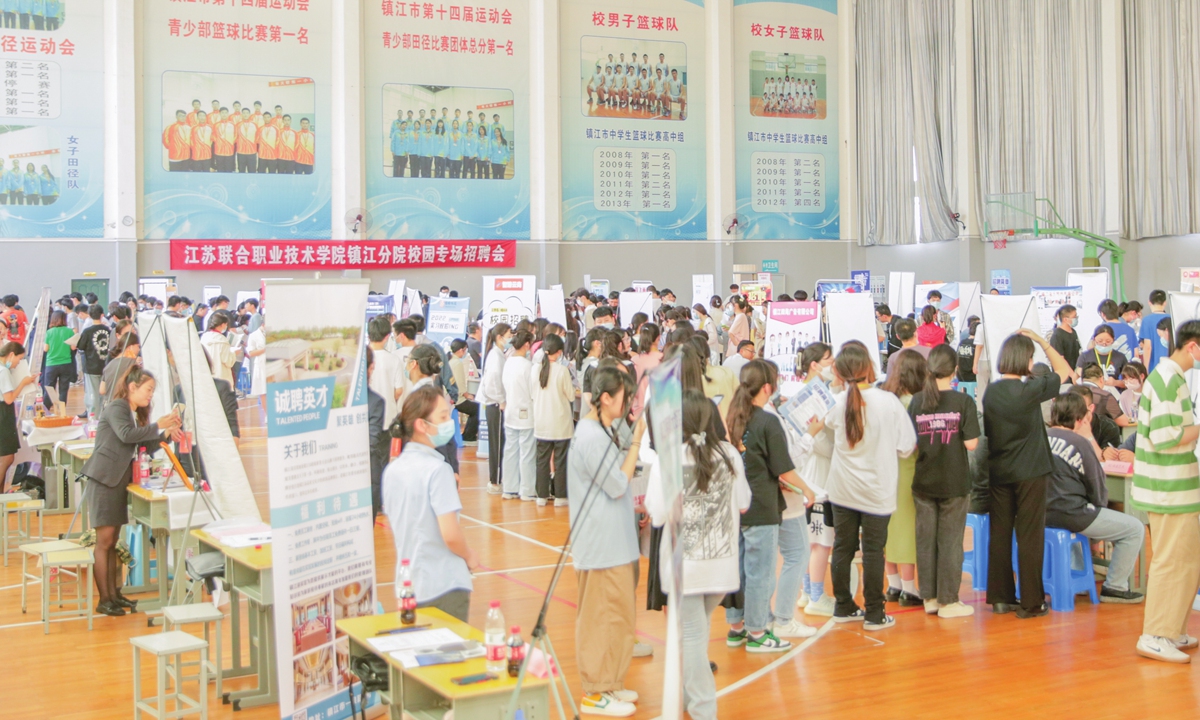
A special campus job fair is held at Zhenjiang Vocational Technical College on June 2, 2022, aiming to boost employment of graduates and facilitate the resumption of work for local companies. Photo: IC
China's job market continued to brighten in the third quarter of the year compared with the first two quarters, as economic activities also improved thanks to policy support, according to data released by the National Bureau of Statistics (NBS) on Monday.
The national surveyed urban unemployment rate in the third quarter came in at 5.4 percent, down 0.4 percentage points from the previous quarter. In the first nine months, the rate reached 5.6 percent.
The employment situation improved in the third quarter, with the employment of key groups effectively guaranteed and the overall employment situation remained stable, said Wang Pingping, an official from the NBS.
As a result of the government's efforts to stabilize the job market, China's surveyed urban unemployment rate continued to fall in the third quarter, coming in at 5.4 percent in July and 5.3 percent in August.
The unemployment rate picked up slightly to 5.5 percent in September due to sporadic COVID-19 cases, according to data from the NBS.
One highlight of Monday's data is that the unemployment rate among people aged between 25 and 29 dropped significantly in the third quarter to 4.4 percent, significantly lower than the 4.9 percent in the first quarter and 5 percent in the second quarter.
The unemployment rate for people aged 16-24 fell for two consecutive months to 17.9 percent in September, down 2 percentage points from a high level in July.
The improved employment situation was the result of efficient coordination between epidemic prevention and economic and social development, as well as the vigorous implementation of various policies to stabilize growth and employment, Wang noted.
Support policies are a major factor for a stable job market for key groups. To tackle the high youth unemployment rate, the nation increased efforts to help unemployed college graduates find jobs, and it has implemented special skill training programs for young people.
The improved situation in the industrial production and services industry job markets also helped to lower unemployment levels, Tian Yun, a veteran economist based in Beijing, told the Global Times on Monday.
In the third quarter, the added value of industrial enterprises above designated size increased by 4.8 percent year-on-year, 4.1 percentage points higher than that in the second quarter.
Data from the NBS also showed that the service industry production index grew 1.2 percent year-on-year in the third quarter, 4.5 percentage points higher than that of the second quarter, as relief policies took effect.
There is a growing group of people all over China who are flexibly employed, which has created the space to absorb the unemployed, such as ride-hailing drivers, vloggers and take-away deliverymen, Dong Dengxin, Director of the Finance and Securities Institute of the Wuhan University of Science and Technology, told the Global Times on Monday.
Some 200 million Chinese are now flexibly employed across the country, NBS data showed.
Although the surveyed urban unemployment rate picked up in September due to the impact of the pandemic, there are reliable conditions for employment to remain stable in the next stage, according to officials.
The sustained economic recovery, various support policies aimed at market entities and emergence of new industries and jobs are expected to further stabilize employment, Wang said.
Global Times




